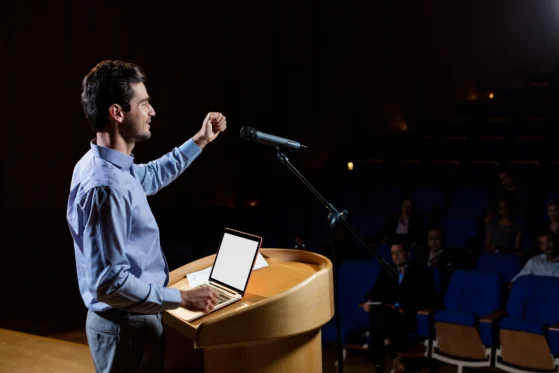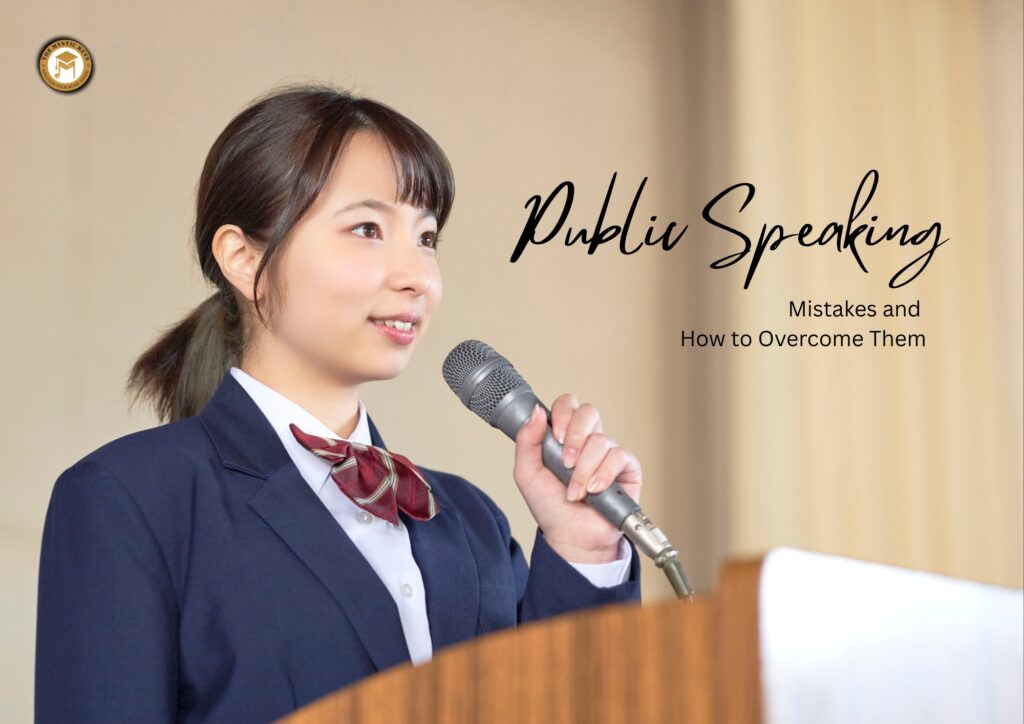Public Speaking Mistakes and How to Overcome Them
Public speaking is an essential skill in both personal and professional life. Whether you are presenting at work, addressing a large audience, or delivering a speech at an event, the ability to communicate effectively can leave a lasting impression. Yet, even experienced speakers sometimes make public speaking mistakes that diminish their impact. By recognizing these common public speaking mistakes and learning how to avoid them, you can elevate your speaking skills and captivate any audience.

Lack of Preparation | A Foundational Public Speaking Mistake
One of the most fundamental errors is walking onto a stage or podium without adequate preparation. Many people assume that “winging it” is sufficient, especially if they are knowledgeable about their topic. However, improvisation alone rarely produces a coherent or impactful speech. Without a clear structure, speakers may forget important points, stumble over words, or experience awkward pauses that undermine their credibility.
How to improve: Start by clearly identifying the purpose of your speech. Is it to inform, persuade, or entertain? Once you know your goal, outline your main points and support them with facts, stories, or examples. Rehearse multiple times—preferably in front of a mirror, a recording device, or a trusted friend who can give feedback. Familiarity with your material reduces anxiety, boosts confidence, and allows you to respond naturally to audience reactions.
Imagine preparing a presentation for a workplace meeting without rehearsing. Even if your content is excellent, a lack of preparation can make it seem scattered or unconvincing. Preparation lays the foundation for confidence and smooth delivery.

Overloading the Audience with Information
Another frequent mistake is attempting to cover too much information at once. Speakers, in their enthusiasm, often cram details, statistics, and examples into a single talk. While thoroughness may feel like thoroughness, it can overwhelm the audience. When listeners are presented with an avalanche of information, their retention drops, and they may leave the room remembering only fragments of your message.
How to improve: Focus on clarity and simplicity. Identify three to four main points to highlight, and illustrate each with stories, anecdotes, or examples that resonate. If you use slides, ensure they complement your words instead of overwhelming them with dense text or complex charts. Simplifying your message doesn’t dilute it—it makes it more memorable and impactful.
Consider the difference between a speaker listing ten statistics in rapid succession versus one who shares three meaningful insights with engaging stories. The audience will connect more deeply with the latter approach, remembering both the content and the speaker.

Reading from Slides or Notes | A Public Speaking Mistake
Many speakers make one of the common public speaking mistakes by leaning heavily on slides or printed notes, thinking it will keep them on track. While these tools can be helpful, over-reliance often reduces engagement. Audiences tend to lose interest when a speaker reads line by line from slides or notes, as it creates distance between the speaker and listener.
How to improve: Use slides or notes only as prompts. Bullet points are better than full sentences, allowing you to glance quickly and continue making eye contact with your audience. Practicing without relying on slides trains you to speak naturally, respond to the room, and maintain connection.
Imagine attending a lecture where the speaker’s eyes rarely leave the screen. Even the most informative content can feel lifeless if delivery suffers from this public speaking mistake. Your voice, presence, and interaction with the audience are what truly bring your message to life.

Poor Body Language | A Subtle Public Speaking Mistake
Non-verbal cues speak volumes. Standing stiffly, fidgeting, slouching, or avoiding eye contact can convey insecurity, disinterest, or discomfort—even if your words are compelling. Conversely, open, confident body language draws the audience in and reinforces your message.
How to improve: Practice standing tall, using natural gestures to emphasize points, and making eye contact with different sections of the room. Purposeful movement, occasional smiles, and a relaxed stance communicate confidence and approachability. Your body language should support your message rather than distract from it.
Even a well-structured and rehearsed speech can lose impact if the speaker appears nervous or disengaged. The audience notices subtle signals, from crossed arms to pacing too rapidly, which can undermine credibility.

Speaking Too Fast or Too Slowly
Nervousness can push speakers to rush through their material, while others speak so slowly that the audience loses focus. Both extremes disrupt comprehension and diminish the effectiveness of a presentation.
How to improve: Aim for a measured pace that allows your words to be absorbed. Pausing briefly after key points gives the audience time to reflect. Practicing with a timer or recording yourself helps you gauge whether your delivery is too fast, too slow, or just right. Using emphasis and intonation strategically creates rhythm and engages listeners.
Think of it this way: a speech delivered like a rushed news broadcast leaves little room for connection, while a monotone crawl risks putting your audience to sleep. Mastering pacing makes your content both accessible and compelling.

Ignoring the Audience | A Public Speaking Mistake That Reduces Impact
A common pitfall is focusing exclusively on personal delivery instead of paying attention to audience reactions. Speakers who overlook engagement risk appearing detached or unrelatable.
How to improve: Involve your audience through questions, anecdotes, or interactive elements. Observe their responses—nods, smiles, or confused looks—and adjust accordingly. A speech becomes far more effective when it feels like a conversation rather than a one-sided lecture.
Even the most prepared speaker can lose impact if the audience isn’t considered. Eye contact, gestures, and timely responses create rapport, making the audience feel seen and valued.

Overuse of Filler Words
Words like “um,” “uh,” “like,” and “you know” are common in spontaneous speech but can distract and reduce credibility. Frequent fillers suggest uncertainty or nervousness.
How to improve: Awareness is key. Record practice sessions to identify where fillers occur. Replace them with thoughtful pauses or deep breaths. Gradually, your speech will become more deliberate and confident, helping you maintain authority and listener attention.
Small changes in delivery, such as eliminating filler words, can significantly elevate your professional presence.

Neglecting Vocal Variety
A monotone voice can make even the most fascinating content sound dull. Without variation in pitch, volume, and emphasis, listeners struggle to stay engaged.
How to improve: Experiment with changing tone, emphasizing key words, and adjusting pace to highlight important ideas. Vocal variety conveys emotion and enthusiasm, making your speech dynamic and memorable.
Imagine two speakers presenting identical content—one with a lively, expressive voice and the other monotone. Which one would you remember? The difference often lies not in what is said, but in how it is delivered.

Failing to Handle Questions or Interruptions
Unexpected questions or interruptions can throw a speaker off, creating awkward pauses or a loss of confidence.
How to improve: Anticipate potential questions and prepare concise, clear responses. If you don’t know an answer, it’s acceptable to acknowledge it and offer to follow up later. Remaining calm and professional under pressure demonstrates credibility and poise.
Handling interruptions gracefully shows mastery over both your content and your delivery, earning respect from the audience.

Not Practicing Enough
Even experienced speakers can falter without adequate rehearsal. Underestimating the importance of practice often leads to inconsistent pacing, forgotten points, or uncomfortable gestures.
How to improve: Rehearse multiple times, focusing on timing, clarity, and non-verbal cues. Practice in front of friends or record yourself for feedback. Regular practice builds muscle memory, making your delivery smooth, natural, and confident.
Repetition ensures that, when it matters most, your message comes across clearly and convincingly.

Conclusion
Public speaking is a skill that can be honed with awareness, effort, and consistent practice. Recognizing and avoiding common public speaking mistakes—such as lack of preparation, overwhelming the audience, poor body language, monotone delivery, overuse of filler words, and neglecting audience engagement—can dramatically improve your effectiveness. At The Mystic Keys, our Public Speaking Course Online is designed to help learners identify these mistakes and develop the confidence, clarity, and presence needed to engage any audience.
Confidence comes from thorough preparation, mindful practice, and an authentic connection with your listeners. Each speech presents an opportunity to inform, inspire, and leave a lasting impression. By focusing on clarity, engagement, and presence, anyone can become a compelling, memorable speaker who captivates and resonates with any audience.
For more information and exciting resources about learning music, visit our website at The Mystic Keys. For more music content and exciting offers follow us on
Facebook, Instagram, YouTube, LinkedIn, Twitter, Pinterest, and Threads.








